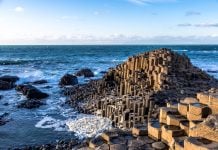Is Iceland the tip of a vast, sunken continent? Academics believe they have identified a remarkable geological secret; a sunken continent hidden under Iceland and the surrounding ocean, which they have dubbed ‘Icelandia’.

An international team of geologists believe the sunken continent could stretch from Greenland all the way to Europe.
It is believed to cover an area of ~ 600,000 km2 but when adjoining areas west of Britain are included in a “Greater Icelandia” the entire area could be ~1,000,000 km2 in size.
Pangea has not fully brocken up
If proven, it means that the giant supercontinent of Pangaea, which is thought to have broken up over 50 million years ago, has in fact not fully broken up.
This new theory challenges long-held scientific ideas around the extent of oceanic and continental crust in the North Atlantic region, and how volcanic islands, like Iceland, formed.
The presence of continental, rather than oceanic, crust could also spark discussions about a new source of minerals and hydrocarbons, both of which are contained in continental crust.
Discovery of the sunken continent under Iceland
Speaking about the new theory Professor Foulger said:
“Until now Iceland has puzzled geologists as existing theories that it is built of, and surrounded by, oceanic crust are not supported by multiple geological data. For example, the crust under Iceland is over 40 km thick – seven times thicker than normal oceanic crust. This simply could not be explained.
“However, when we considered the possibility that this thick crust is continental, our data suddenly all made sense. This led us immediately to realise that the continental region was much bigger than Iceland itself – there is a hidden continent right there under the sea.
“There is fantastic work to be done to prove the existence of Icelandia but it also opens up a completely new view of our geological understanding of the world. Something similar could be happening at many more places.
“We could eventually see maps of our oceans and seas being redrawn as our understanding of what lies beneath changes.”
So what if Pangea never broke apart?
Important legal and political ramifications
This work has important legal and political ramifications as, under certain conditions, the United Nations Convention on the Law of the Sea grants coastal states exclusive rights to the non-living resources of their adjacent seabed if scientists can prove that the seabed is a submerged extension of the continental landmass.
Professor Philip Steinberg, Director of IBRU, Durham University’s Centre for Borders Research, noted: “Countries around the world are spending enormous resources conducting subsea geologic research in order to identify their continental shelves and claim exclusive mineral rights there.
“Research like Professor Foulger’s, which forces us to rethink the relationship between seabed and continental geology can have far-reaching impact for countries trying to determine what area of the seabed are their exclusive preserve and what areas are to be governed by the International Seabed Authority as the ‘common heritage of humankind.” [Geo Society]
Now subscribe to this blog to get more amazing news curated just for you right in your inbox on a daily basis (here an example of our new newsletter).
You can also follow us on Facebook and/ or Twitter. And, by the way you can also make a donation through Paypal. Thank you!
You should really subscribe to QFiles to get very interesting information about strange events around the world.














With mineral resources at stake, you can bet there will be corrupted data.